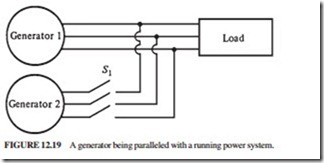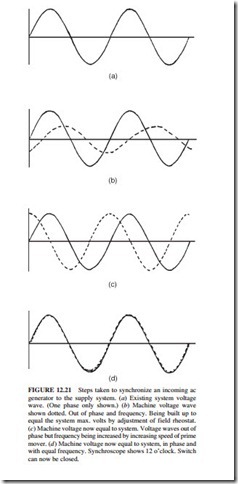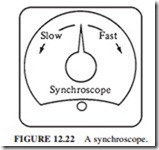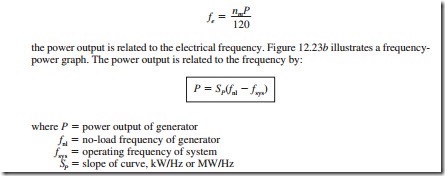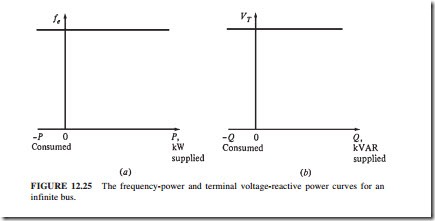PARALLEL OPERATION OF AC GENERATORS
In most generator applications, there is more than one generator operating in parallel to supply power to various loads. The North American grid is an extreme example of a situation where thousands of generators share the load on the system.
The major advantages for operating synchronous generators in parallel are as follows:
1. The reliability of the power system increases when many generators are operating in parallel, because the failure of any one of them does not cause a total power loss to the loads.
2. When many generators operate in parallel, one or more of them can be taken out when failures occur in power plants or for preventive maintenance.
3. If one generator is used, it cannot operate near full load (because the loads are changing), then it will be inefficient. When several machines are operating in parallel, it is possible to operate only a fraction of them. The ones that are operating will be more efficient because they are near full load.
The Conditions Required for Paralleling
Figure 12.19 illustrates a synchronous generator G1 supplying power to a load with another generator G2 that is about to be paralleled with G1 by closing the switch S1. If the switch is closed at some arbitrary moment, the generators could be severely damaged and the load may lose power. If the voltages are different in the conductors being tied together, there will be very large current flow when the switch is closed.
This problem can be avoided by ensuring that each of the three phases has the same voltage magnitude and phase angle as the conductor to which it is connected. To ensure this match, these paralleling conditions must be met:
1. The two generators must have the same rms line voltages.
2. The phase sequence must be the same in the two generators.
3. The two a phases must have the same phase angles.
4. The frequency of the oncoming generator must be slightly higher than the frequency of the running system.
If the sequence in which the phase voltages peak in the two generators is different (Fig. 12.20a), then two pairs of voltages are 120° out of phase, and only one pair of voltages (the a phases) is in phase. If the generators are connected in this manner, large currents will flow in phases b and c, causing damage to both machines.
The phase sequence problem can be corrected by swapping the connections on any two of the three phases on one of the generators.
If the frequencies of the power supplied by the two generators are not almost equal when they are connected together, large power transients will occur until the generators stabilize at a common frequency. The frequencies of the two generators must differ by a small amount so that the phase angles of the oncoming generator will change slowly relative to the phase angles of the running system. The angles between the voltages can be observed, and switch S1 can be closed when the systems are exactly in phase.
The General Procedure for Paralleling Generators
If generator G2 is to be connected to the running system (Fig. 12.20), the following steps should be taken to accomplish paralleling:
1. The terminal voltage of the oncoming generator should be adjusted by changing the field current until it is equal to the line voltage of the running system.
2. The phase sequences of the oncoming generator and of the running system should be the same. The phase sequence can be checked by using the following methods:
a. A small induction motor can be connected alternately to the terminals of each of the two generators. If the motor rotates in the same direction each time, then the phase sequences of both generators are the same. If the phase sequences are different, the motors will rotate in opposite directions. In this case, two of the conductors on the incoming generator must be reversed.
b. Figure 12.20b illustrates three lightbulbs connected across the terminals of the switch connecting the generator to the system. When the phase changes between the two systems, the lightbulbs become bright when the phase difference is large and dim when the phase difference is small. When the systems have the same phase sequence, all three bulbs become bright and dim simultaneously. If the systems have opposite phase sequence, the bulbs get bright in succession.
The frequency of the oncoming generator should be slightly higher than the frequency of the running system. A frequency meter is used until the frequencies are close; then changes in phase between the the generator and the system are observed.
The frequency of the oncoming generator is adjusted to a slightly higher frequency to ensure that when it is connected, it will come on-line supplying power as a generator, instead of consuming it as a motor.
Once the frequencies are almost equal, the voltages in the two systems will change phase relative to each other very slowly. This change in phase is observed, and the switch connecting the two systems together is closed when the phase angles are equal (Fig. 12.21). A confirmation that the two systems are in phase can be achieved by watching the three lightbulbs. The systems are in phase when the three lightbulbs all go out (because the voltage difference across them is zero).
This simple scheme is useful, but it is not very accurate. A synchroscope is more accurate. It is a meter that measures the difference in phase angle between the a phases of the two systems (Fig. 12.22). The phase difference between the two a phases is shown by the dial. When the systems are in phase (0° phase difference), the dial is at the top. When they are 180° out of phase, the dial is at the bottom.
The phase angle on the meter changes slowly because the frequencies of the two systems are slightly different. Since the oncoming generator frequency is slightly higher than the system frequency, the synchroscope needle rotates clockwise because the phase angle advances. If the oncoming generator frequency is lower than the system frequency, the
(c) Machine voltage now equal to system. Voltage waves out of phase but frequency being increased by increasing speed of prime mover. (d) Machine voltage now equal to system, in phase and with equal frequency. Synchroscope shows 12 o’clock. Switch can now be closed.
needle rotates counterclockwise. When the needle of the synchroscope stops in the vertical position, the voltages are in phase and the switch can be closed to connect the systems.
However, the synchroscope provides the relationship for only one phase. It does not provide information about the phase sequence.
The whole process of paralleling large generators to the line is done by a computer. For small generators, the operator performs the paralleling steps.
Frequency-Power and Voltage-Reactive Power Characteristics of a Synchronous Generator
The mechanical source of power for the generator is a prime mover such as diesel engines or steam, gas, water, and wind turbines. All prime movers behave in a similar fashion. As the power drawn from them increases, the rotational speed decreases. In general, this decrease in speed is nonlinear. However, the governor makes this decrease in speed linear with increasing power demand.
Thus, the governing system has a slight speed drooping characteristic with increasing load. The speed droop (SD) of a prime mover is defined by where nnl is the no-load speed of the prime mover and nfl is the full-load speed of the prime mover. The speed droop of most generators is usually 2 to 4 percent. In addition, most governors have a set-point adjustment to allow the no-load speed of the turbine to be varied. A typical speed-power curve is shown in Fig. 12.23.
Since the electrical frequency is related to the shaft speed and the number of poles by
The reactive power Q has a similar relationship with the terminal voltage VT . As pre- viously described, the terminal voltage drops when a lagging load is added to a synchronous generator. The terminal voltage increases when a leading load is added to a synchro- nous generator. Figure 12.24 illustrates a plot of terminal voltage versus reactive power.
This plot has a drooping characteristic that is not generally linear, but most generator voltage regulators have a feature to make this characteristic linear.
When the no-load terminal voltage set point on the voltage regulator is changed, the curve can slide up and down.
The frequency-power and terminal voltage-reactive power characteristics play important roles in parallel operation of synchronous generators. When a single generator is operating alone, the real power P and reactive power Q are equal to the amounts demanded by the loads.
The generator’s controls cannot control the real and reactive power supplied. Therefore, for a given real power, the generator’s operating frequency fe is controlled by the governor set points, and for a given reactive power, the generator’s terminal voltage VT is controlled by the field current.
Related posts:
Incoming search terms:
- parallel operation of synchronous generator
- parallel operation of synchronous generators
- load sharing in parallel operation of alternators
- parallel operation of synchronous generator pdf
- parallel operation of alternator
- conditions for parallel operation of generators
- conditions for parallel operation of synchronous generators
- parallel operation of synchronous alternator
- parallel operation of generators
- advantage parallel operation of alternators ppt
- parallel operation of synchronous generator ppt
- parallel operation of two generators
- parallel operation of AC Generator
- what are the advantages of parallel operation of alternator
- parallel operation of alternators pdf
- conditions to be met for generator to be connected
- ac generator parallel operation
- define parallel operation of a sychronous generator
- state reasons for parallel operation of synchronous generators
- if the no load frequency of on-coming generator is lower than system
- generator load sharing calculation
- calculations on parallel excited synchronous generators
- parallel operation of ac generators
- parallel operation of generator
- governor characteristics of synchronous generator
- numerical examples on synchronuos generator
- parallel operation of synchronous motor
- parallel operations of 3 phase synchronous generator
- earthing of paralled generators
- parallel operation of generators ppt
- parallel operation of alternators
- principles of the parallel operation of generators
- principle of generator load sharing
- parallel operation of two alternator
- synchronous machines parallel operation
- how load sharing is affected in paralleling generators
- synchronous generators in parallel
- generator load sharing principle
- Synchronization or Paralleling of generators ppt
- parallel operation in synchronous generator
- need of parallel operation of synchronous generator
- why it is necessary that the two or multiple generators must operate in synchronous manner
- two synchronous generators in parallel
- parallel opration of synchronous motor
- generator load sharing problems
- general operation of parallel sychronous generator
- control of parallel operation of synchronous generator seminar
- explain the parallel and synchronization of three phase synchronous generator
- parallel running and load sharing of alternators
- parallel operation on alternator advantages some information
